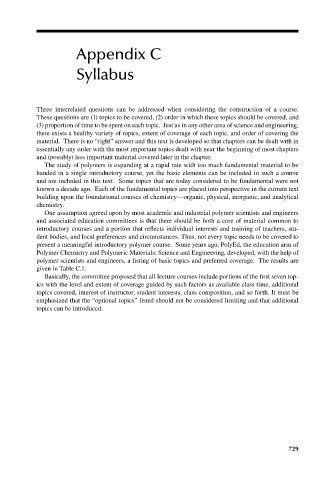Page 766 - Carrahers_Polymer_Chemistry,_Eighth_Edition
P. 766
Appendix C
Syllabus
Three interrelated questions can be addressed when considering the construction of a course.
These questions are (1) topics to be covered, (2) order in which these topics should be covered, and
(3) proportion of time to be spent on each topic. Just as in any other area of science and engineering,
there exists a healthy variety of topics, extent of coverage of each topic, and order of covering the
material. There is no “right” answer and this text is developed so that chapters can be dealt with in
essentially any order with the most important topics dealt with near the beginning of most chapters
and (possibly) less important material covered later in the chapter.
The study of polymers is expanding at a rapid rate with too much fundamental material to be
handed in a single introductory course, yet the basic elements can be included in such a course
and are included in this text. Some topics that are today considered to be fundamental were not
known a decade ago. Each of the fundamental topics are placed into perspective in the current text
building upon the foundational courses of chemistry—organic, physical, inorganic, and analytical
chemistry.
One assumption agreed upon by most academic and industrial polymer scientists and engineers
and associated education committees is that there should be both a core of material common to
introductory courses and a portion that reflects individual interests and training of teachers, stu-
dent bodies, and local preferences and circumstances. Thus, not every topic needs to be covered to
present a meaningful introductory polymer course. Some years ago, PolyEd, the education arm of
Polymer Chemistry and Polymeric Materials: Science and Engineering, developed, with the help of
polymer scientists and engineers, a listing of basic topics and preferred coverage. The results are
given in Table C.1.
Basically, the committee proposed that all lecture courses include portions of the first seven top-
ics with the level and extent of coverage guided by such factors as available class time, additional
topics covered, interest of instructor, student interests, class composition, and so forth. It must be
emphasized that the “optional topics” listed should not be considered limiting and that additional
topics can be introduced.
729
9/14/2010 3:44:34 PM
K10478.indb 729
K10478.indb 729 9/14/2010 3:44:34 PM

